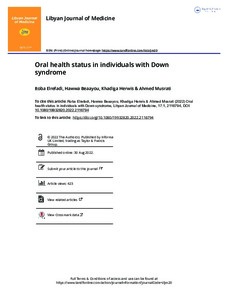Oral health status in individuals with Down syndrome
Elrefadi Roba; Beaayou Hawwa; Herwis Khadiga; Musrati Ahmed
Oral health status in individuals with Down syndrome
Elrefadi Roba
Beaayou Hawwa
Herwis Khadiga
Musrati Ahmed
TAYLOR & FRANCIS LTD
Julkaisun pysyvä osoite on:
https://urn.fi/URN:NBN:fi-fe2022102463138
https://urn.fi/URN:NBN:fi-fe2022102463138
Tiivistelmä
Down syndrome (DS) is a neurodevelopmental disorder of known genetic cause, with a wide array of oral and systemic manifestations. The aim of the present study is to determine the level of oral hygiene status and practice of a group of individuals with DS in Benghazi/Libya. In this cross-sectional study 124 individuals were recruited from The Rehabilitation Centre of Special Needs in the city of Benghazi, Libya. Questionnaires were distributed among the attendees, covering oral health aspects and diet habits. Oral examination was conducted to evaluate oral health status among individuals with DS. The data were analysed descriptively and inferentially (including Chi-square test and Fisher's exact test) using the Statistical Package for Social Science version 20 (SPSS). Most of DS individuals brush their teeth once daily (62%), spending less than one minute in brushing (44%). For diet habits, more than half (55%) eat sweet snacks between meals. For the dental status, 47% of the subject had zero DMFT, followed by score 2 in 21%. The highest percentage in Oral hygiene Index (OHI) was scored 1 by 46% of participants. The zero CPITN score was seen in 54.5%. Our results have shown a weaker tendency of DS towards oral hygiene. This should strengthen our goal of guiding and encouraging parents of individuals with DS to be more cautious in providing help and supervision of their individuals' practice of oral health care.
Kokoelmat
- Rinnakkaistallenteet [27094]
